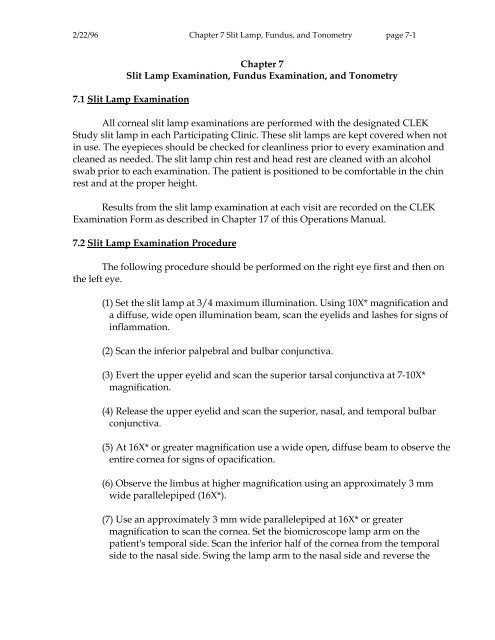OM t of c.iii - Vision Research Coordinating Center - Washington ...
OM t of c.iii - Vision Research Coordinating Center - Washington ...
OM t of c.iii - Vision Research Coordinating Center - Washington ...
Create successful ePaper yourself
Turn your PDF publications into a flip-book with our unique Google optimized e-Paper software.
2/22/96 Chapter 7 Slit Lamp, Fundus, and Tonometry page 7-1<br />
Chapter 7<br />
Slit Lamp Examination, Fundus Examination, and Tonometry<br />
7.1 Slit Lamp Examination<br />
All corneal slit lamp examinations are performed with the designated CLEK<br />
Study slit lamp in each Participating Clinic. These slit lamps are kept covered when not<br />
in use. The eyepieces should be checked for cleanliness prior to every examination and<br />
cleaned as needed. The slit lamp chin rest and head rest are cleaned with an alcohol<br />
swab prior to each examination. The patient is positioned to be comfortable in the chin<br />
rest and at the proper height.<br />
Results from the slit lamp examination at each visit are recorded on the CLEK<br />
Examination Form as described in Chapter 17 <strong>of</strong> this Operations Manual.<br />
7.2 Slit Lamp Examination Procedure<br />
The following procedure should be performed on the right eye first and then on<br />
the left eye.<br />
(1) Set the slit lamp at 3/4 maximum illumination. Using 10X* magnification and<br />
a diffuse, wide open illumination beam, scan the eyelids and lashes for signs <strong>of</strong><br />
inflammation.<br />
(2) Scan the inferior palpebral and bulbar conjunctiva.<br />
(3) Evert the upper eyelid and scan the superior tarsal conjunctiva at 7-10X*<br />
magnification.<br />
(4) Release the upper eyelid and scan the superior, nasal, and temporal bulbar<br />
conjunctiva.<br />
(5) At 16X* or greater magnification use a wide open, diffuse beam to observe the<br />
entire cornea for signs <strong>of</strong> opacification.<br />
(6) Observe the limbus at higher magnification using an approximately 3 mm<br />
wide parallelepiped (16X*).<br />
(7) Use an approximately 3 mm wide parallelepiped at 16X* or greater<br />
magnification to scan the cornea. Set the biomicroscope lamp arm on the<br />
patient's temporal side. Scan the inferior half <strong>of</strong> the cornea from the temporal<br />
side to the nasal side. Swing the lamp arm to the nasal side and reverse the
















